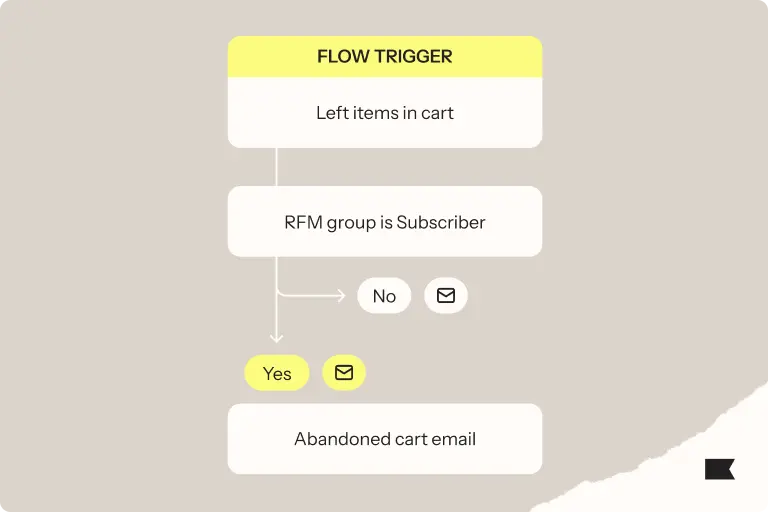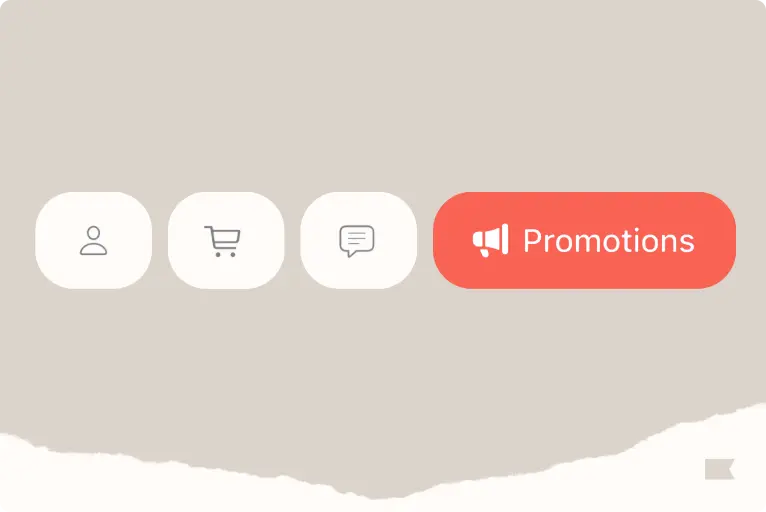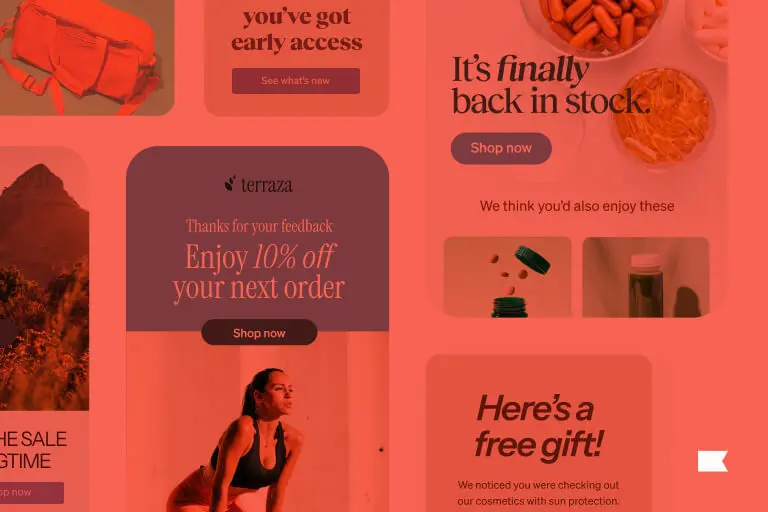How to grow your email list: 5 examples from fast-growing brands
Email list growth strategies are more important now than they ever have been.
There are a few reasons for that:
- Over 76% of businesses of all sizes place email marketing in the top 3 ROI-generating marketing channels, according to Klaviyo’s marketing mix report.
- According to a 2023 GWI report representing more than 970K consumers, people are starting to use social media—particularly TikTok—in a more intentional way, as opposed to mindlessly scrolling. (Great for mental health; not so great for ads.)
- Apple’s iOS14 changes wiped out much of the audience-targeting parameters that made paid social a cost-effective option for small businesses. Cost per acquisition has since soared, and return on ad spend has plummeted.
- Besides TikTok (which is currently under threat in the US), average daily time spent on social media declined globally in 2023 compared to 2022, according to the 2023 GWI report.
It’s not so much that paid social is completely ineffective—it’s just that it’s no longer affordable for most small- to medium-sized businesses.
This is why more brands are experimenting with new ways to grow their lists as part of a sound customer acquisition strategy.
The data you own is the data you can learn from, slice up, and build on to craft the perfect message for every segment of your audience. Owned marketing puts you in the driver’s seat.
If you’re looking for ideas to grow your email list in new, creative ways, you’re in the right place. Here, we look at 4 ecommerce company use cases on personalized and creative list growth—with next steps on how you can achieve something similar.
1. Andie Swim personalizes the sign-up process with an interactive quiz
Interactive quizzes are a great way to accomplish 3 things:
- Collect zero-party customer data on product preferences.
- Build your email list.
- Develop a custom welcome series that can drive more sales.
Quizzes are especially powerful for helping consumers narrow down their options. Andie Swim leverages a personalized fit quiz powered by Digioh to help their shoppers find their perfect swimsuit fit and style. In just 8 months, the flow based on the quiz results drove more than $70K in revenue.

Quizzes: best practices
Think of a quiz as a concierge service. Yes, you want to collect an email address and find out about preferences—but the primary function of a quiz is to help people find the best products for their unique needs.
To make sure your quizzes are helpful, use the following 4 categories to guide your creation:
Help shoppers identify products through their own high-level preferences, whether aesthetic, lifestyle, etc.
Great for beauty brands, this type of quiz matches shoppers with products based on a personal routine.
Help consumers who can’t physically engage with a product find exactly what they need online.
Demonstrate the benefits of a product that requires more education before making a decision to buy.
This information helps your prospects and customers find the product that best fits their needs, and it gets you more zero-party data you can use to segment your lists and send even more personalized emails and text messages.
2. Sanzo grows their list size with partnerships and collabs
If you’re a small brand that’s just starting to build your email list, partnering with a large brand could be the kickstart you need to get a lot of subscribers, fast.
Look for brands that are more well-known than yours, but haven’t yet formed partnerships in your category. This cross-section will make for a great partnership, wherein both brands have something to gain.
Your brand partnership will likely be about much more than building an email list. But as you’re finalizing the details, here are some options you can include to make sure email list building is part of it:
Use your partner’s email list to run a contest that requires an email subscription to enter.
Create posts for your partner to run on their accounts to encourage people to subscribe to your email list (with an incentive).
Develop a co-branded email subscription form for your partner’s website.
Develop limited-edition co-branded products with your partner, and encourage an email sign-up for VIP access.
A great example of a co-branded product is sparkling water brand Sanzo’s partnership with Disney-owned Marvel. To celebrate Asian culture in film, Sanzo created a co-branded, limited-edition lychee drink collection featuring characters from the film on the can.

Since 2018, sales had been growing for Sanzo by at least 400% each year. But the month of the Shang-Chi and the Legend of the Ten Rings sparkling water launch, Sanzo saw 6x growth in ecommerce revenue.
Partnerships + collabs: best practices
A few words of caution about brand partnerships: Subscribers you gather from brand partnerships may have subscribed just because they wanted to win something—not because they’re actually interested in your brand.
With that in mind, make sure you:
- Properly vet brands your looking to partner with.
- Don’t overdo this tactic—once a year is plenty.
- Clean your lists frequently.
If you’re doing lots of giveaways and contests and realize they’re bringing in subscribers who don’t engage, try shifting to partnerships that feature bundles and co-branded products.
3. Never Fully Dressed earns referrals for list growth
Some of the best people to help grow your email list are your most loyal customers.
If you have a loyalty program, use a points system to incentivize an email sign-up, either from the customer or someone the customer knows.
When you use a points system, you’re attaching certain customer actions to benefits.
For example, UK fashion brand Never Fully Dressed values their email list so much that they offer 100 points for an email sign-up—double the amount for following their Instagram account.

Referral email growth: best practices
Segmentation is your best friend when looking to grow your email list through referrals. Not all customers will love your brand enough to refer you, even for points, so you’ll want to single out your VIPs to help grow your list.
In Klaviyo, you can set up customer segments through integrations with loyalty platforms like LoyaltyLion, then send personalized emails. When you’ve decided which customer segments are most likely to refer—based on either number of purchases or amount spent—you can run an email list growth campaign by:
- Sending an email to your most loyal customers with an incentive to refer
- A/B testing a contest incentive vs. a points incentive vs. a discount incentive
- Running follow-up campaigns for segments that haven’t completed a referral, excluding those who have
Consider running these campaigns in quarterly, bi-annual, and/or annual sprints, similar to what nonprofits do with fundraising pushes.
4. Creekside Nursery uses YouTube to increase sign-up form conversion
If you have a substantial social media audience, it’s important to convert some of those followers to email subscribers. This is because, as we mentioned at the top of this article, social media algorithms and usage are increasingly becoming unreliable ways to access your audience.
The more of your audience you can convert to email, the more control you’ll gain over your business.
Garden center Creekside Nursery started a YouTube channel that grew to more than 100K followers. While they were happy about the success, they needed a list to grow their owned audience, so they weren’t relying so much on YouTube to drive sales directly.

In her videos, founder Jenny Simpson started encouraging viewers to visit the Creekside Nursery website—which boosted pop-up visibility significantly to grow their email list.
Social media list growth: best practices
When you’re able to direct traffic to owned channels, you can increase your ROI while decreasing email retargeting costs. Here are a few ways to make that happen:
Gatsby now allows you to acquire new email & SMS subscribers directly from Instagram DMs––and integrates seamlessly with Klaviyo.
If you want to grow your email list through paid social, consider running a contest campaign. To enter your contest, people who see the ad need to subscribe to your email list. Bonus if you can also incentivize them further to share the post with a friend. If you’re using this strategy, make sure to turn on double opt-in as a way to ensure good list hygiene.
Consider investing in a white-label influencer campaign. This tactic gives you a bit more control over the content of an ad while leveraging an influencer’s audience to ask for email sign-ups. Not sure how to get started? Influencer platforms like Trend.io and #Paid can help streamline this.
If your budget permits, skip the contest and run an ad that incentivizes an email list sign-up with a discount code. This is a great option if you’re launching a new product and want to include paid social as part of your go-to-market strategy. You’ll still generate some revenue from the paid ad campaign, but you’ll also see the long-term benefits of expanding your owned channels.
5. Use a QR code on packages for email sign-ups
There’s almost no one more enthusiastic about your brand than someone who’s unwrapping a package from you. It’s also a perfect moment to capture a subscriber.
QR codes have been around for a long time, but they seem to have found their stride most recently due to the pandemic. Bridging the gap between the physical world and the digital one, QR codes are a fantastic way to link customers to your subscribe page or a survey that captures both their valuable feedback and their email address.
Include a QR code as part of your packaging, and use a UTM link to create a list of customers who subscribed from it. That way you can segment the audience for future loyalty-lite campaigns to move them to a repeat purchase.
What’s next? Make sure you’re sending relevant messages
Segment your list as you build it. As your list grows, you’ll start to notice many more ways to split up your audience, either by online behavior, demographics, lifestyle preferences, or more.
This is why email list building is just the first step to seeing high ROI with email—because email segmentation empowers you to send emails that have a greater impact on your brand’s revenue and reputation.
If you want to keep learning, find out how email segmentation tools have evolved to make email one of the most powerful channels you can invest in for your brand.
Related content
- How to build an email list: 5 beginner strategies for when you’re starting from scratch
- From clutter to conversion: How to maintain email list hygiene for better deliverability
- 4 creative list growth use cases that leverage A/B testing to build an audience, fast



